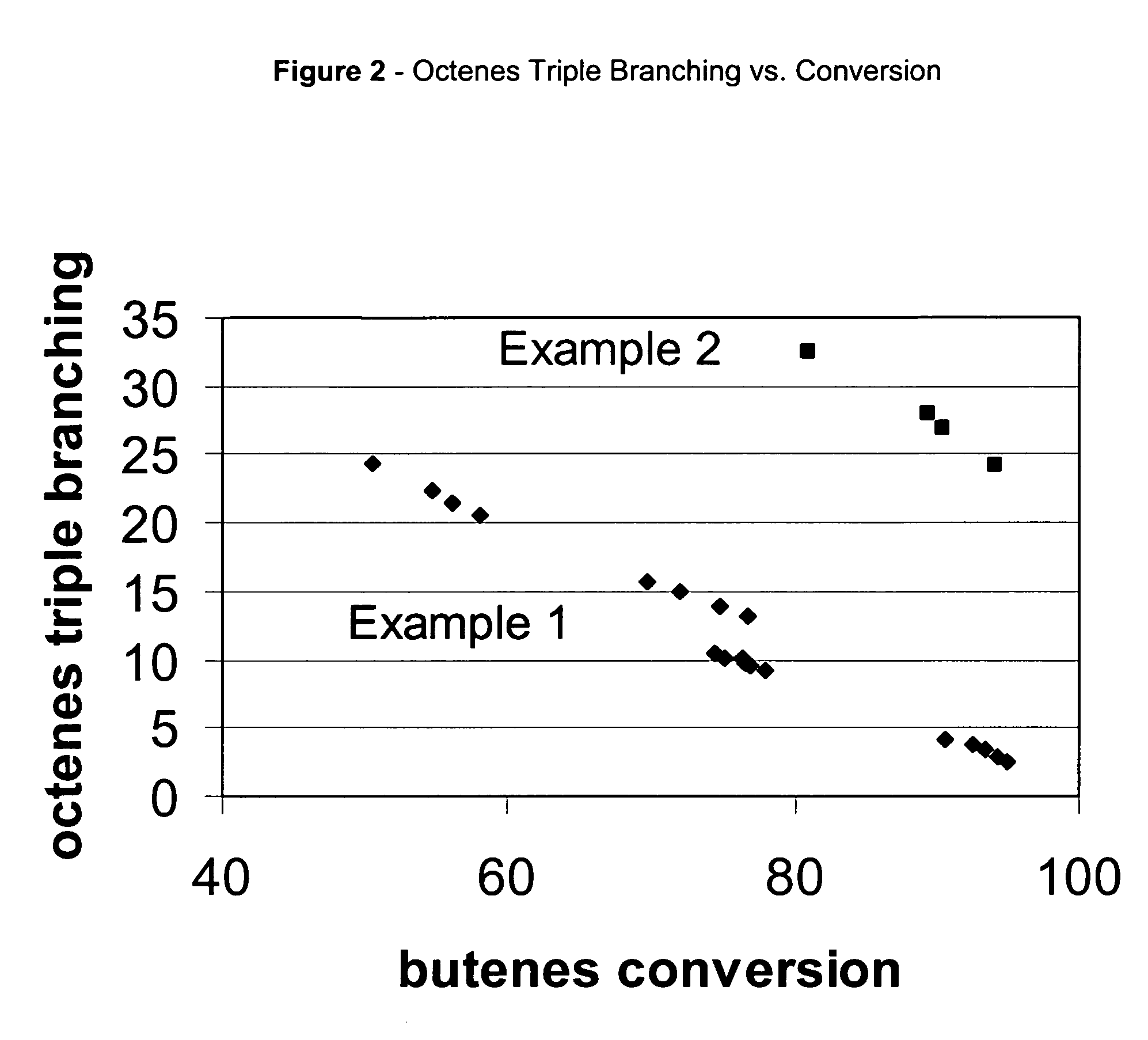Oligomerization of isobutene-containing feedstocks
a technology of isobutene and olefin, which is applied in the preparation of carbonyl compounds, organic chemistry, chemistry apparatus and processes, etc., can solve the problems of high production cost of plasticizers, increased amount of triple-branched octenes, and inability to meet the requirements of certain end uses such as certain plasticizers, and achieves low capital cost and high yield.
- Summary
- Abstract
- Description
- Claims
- Application Information
AI Technical Summary
Benefits of technology
Problems solved by technology
Method used
Image
Examples
example 1
[0060]Commercial ZSM-57 / alumina extrudates were used to process 12 wt % isobutene / 48 wt % n-butene / 10 wt % isobutane / 30 wt % n-butane feedstock. Reaction conditions were 70 bar, 15 WHSV, and 235° C. or 275° C. feedstock inlet temperature. Octenes selectivity vs. conversion is plotted using diamonds in FIG. 1. A single continuous curve is obtained indicating that octenes selectivity is nearly independent of reaction temperature. Product triple branching vs. butanes conversion is plotted using diamonds in FIG. 2. The branch index data falls onto two separate groups. The group between 40 and 75% conversion forms a line at higher triple branching. The group between 70 and 95% conversion forms a line at lower triple branching. Product branch index (BI) vs. conversion is plotted using diamonds in FIG. 3. The group between 40 and 75% conversion forms a line at higher branch index. The group between 70 and 95% conversion forms a line at lower branch index. Triple branching and branch index ...
example 2
[0061]Commercial ZSM-57 / alumina extrudates were used to process 20 wt % isobutene / 46 wt % n-butene / 16 wt % isobutane / 18 wt % n-butane feedstock. Reaction conditions were 70 bar, 15 WHSV, and 175° C. feedstock inlet temperature. Octenes selectivity vs. butanes conversion is plotted in FIG. 1. Percent triple branched isomers in the octenes (octene triple branching) vs. conversion is plotted in FIG. 2. Octenes branching index (BI) vs. conversion is plotted in FIG. 3. At 175° C. the product retains high levels of triple branched products and high BI even at 95% conversion.
[0062]High temperature and conversion operation leads to a step-change decrease in octenes triple branching. Above 90% conversion operating at high temperature reduces the octenes triple branching content from 25 wt % in example 2 to below 5 wt % in Example 1 (FIG. 2). Between 75 and 85% conversion there is surprisingly no octenes selectivity penalty for the high temperature operation. Octenes triple branching decrease...
PUM
| Property | Measurement | Unit |
|---|---|---|
| temperature | aaaaa | aaaaa |
| wt % | aaaaa | aaaaa |
| wt % | aaaaa | aaaaa |
Abstract
Description
Claims
Application Information
 Login to View More
Login to View More - R&D
- Intellectual Property
- Life Sciences
- Materials
- Tech Scout
- Unparalleled Data Quality
- Higher Quality Content
- 60% Fewer Hallucinations
Browse by: Latest US Patents, China's latest patents, Technical Efficacy Thesaurus, Application Domain, Technology Topic, Popular Technical Reports.
© 2025 PatSnap. All rights reserved.Legal|Privacy policy|Modern Slavery Act Transparency Statement|Sitemap|About US| Contact US: help@patsnap.com



